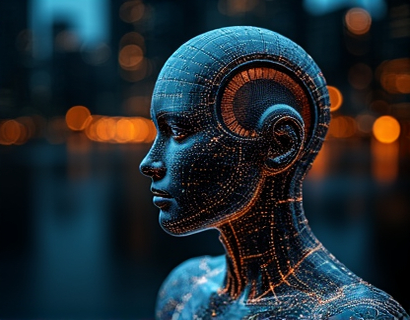Unlocking Digital Transformation: Harnessing AI and Crypto for Enhanced User Experiences
The digital landscape is rapidly evolving, driven by technological advancements that redefine how we interact with online platforms and services. At the forefront of this transformation are two revolutionary technologies: Artificial Intelligence (AI) and Cryptocurrency. When merged, these technologies offer unprecedented opportunities to enhance user experiences, drive innovation, and foster growth in the digital realm. This article explores the synergy between AI and blockchain, highlighting how their integration can lead to groundbreaking solutions that redefine user engagement and satisfaction.
The Intersection of AI and Cryptocurrency
AI and cryptocurrency may seem like disparate entities at first glance, but their convergence holds immense potential. AI, with its ability to process vast amounts of data, learn from patterns, and make intelligent decisions, complements the decentralized and secure nature of cryptocurrency. Together, they can create systems that are not only more efficient and secure but also highly responsive to user needs.
Enhanced Security and Trust
One of the primary advantages of integrating AI with cryptocurrency is the enhancement of security and trust. Blockchain technology inherently provides a secure and transparent ledger for transactions, but AI can further fortify this by detecting and mitigating potential threats in real-time. Machine learning algorithms can analyze transaction patterns to identify anomalies and prevent fraud, ensuring a safer environment for users. This heightened security builds trust, a critical factor in user adoption and retention.
Personalized User Experiences
AI's strength lies in its ability to personalize experiences based on individual preferences and behaviors. In the context of cryptocurrency, this means creating tailored financial solutions that cater to the unique needs of each user. For instance, AI-driven platforms can analyze a user's spending habits and investment preferences to offer customized portfolio recommendations or alert them to potential investment opportunities. This level of personalization not only enhances user satisfaction but also increases engagement and loyalty.
Innovative Applications of AI and Crypto
The combination of AI and cryptocurrency opens up a myriad of innovative applications across various sectors. From finance and healthcare to supply chain management and entertainment, the possibilities are vast. Let's delve into some of these applications to understand their potential impact.
Financial Services
In the financial sector, AI and cryptocurrency can revolutionize traditional banking and investment practices. Smart contracts, powered by blockchain, can automate and enforce contractual obligations with precision, reducing the need for intermediaries and lowering transaction costs. AI can enhance this by providing predictive analytics to forecast market trends, helping users make informed investment decisions. Robo-advisors, driven by AI, can offer personalized financial advice and manage assets, making high-quality financial services accessible to a broader audience.
Healthcare
In healthcare, the integration of AI and cryptocurrency can lead to more efficient and secure patient data management. Blockchain can ensure the integrity and privacy of medical records, while AI can analyze these records to provide insights for better diagnosis and treatment plans. For instance, AI algorithms can identify patterns in patient data to predict disease outbreaks or suggest personalized treatment protocols. Cryptocurrency can facilitate seamless and secure transactions for healthcare services, ensuring that patients and providers are compensated fairly and transparently.
Supply Chain Management
The supply chain industry stands to benefit significantly from the synergy of AI and cryptocurrency. Blockchain can provide a transparent and immutable record of transactions, enhancing traceability and reducing fraud. AI can optimize supply chain operations by predicting demand, managing inventory, and streamlining logistics. For example, AI-driven analytics can forecast consumer demand based on historical data and market trends, enabling businesses to adjust their inventory levels accordingly. Cryptocurrency can simplify payments across the supply chain, reducing the complexity and cost of cross-border transactions.
Entertainment and Media
In the entertainment and media sector, AI and cryptocurrency can transform content creation, distribution, and monetization. Blockchain can ensure that creators are fairly compensated for their work, with smart contracts automatically distributing royalties to rights holders. AI can enhance content recommendation systems, providing users with personalized suggestions based on their viewing history and preferences. Furthermore, cryptocurrency can enable new business models, such as tokenized subscriptions and virtual merchandise, offering creators alternative revenue streams.
Building AI and Crypto Ecosystems
To fully harness the potential of AI and cryptocurrency, it is essential to build robust ecosystems that foster innovation and collaboration. These ecosystems should include developers, researchers, businesses, and users who can contribute to the development and adoption of AI and crypto solutions. Here are some key steps to building such ecosystems:
Fostering Collaboration
Collaboration is crucial for driving innovation in AI and cryptocurrency. Platforms that bring together experts from various fields can facilitate knowledge sharing and joint projects. Conferences, hackathons, and online forums can serve as venues for networking and collaboration, encouraging the exchange of ideas and the development of new technologies.
Encouraging Research and Development
Continuous research and development are essential for advancing AI and cryptocurrency. Funding initiatives, grants, and incubators can support researchers and startups working on cutting-edge projects. Academic institutions and private organizations can collaborate to conduct research, publish findings, and develop practical applications. This ongoing innovation ensures that the technologies remain at the forefront of technological progress.
Creating User-Centric Solutions
User experience should be at the core of any AI and cryptocurrency project. Solutions should be designed with the end-user in mind, focusing on usability, accessibility, and value. User feedback and testing are critical in refining these solutions to meet real-world needs. By prioritizing user-centric design, developers can create applications that are not only technologically advanced but also practical and beneficial.
Challenges and Considerations
While the potential of AI and cryptocurrency is vast, there are several challenges and considerations that must be addressed to ensure successful implementation. Understanding these challenges can help stakeholders navigate the complexities of this emerging landscape.
Regulatory Hurdles
Cryptocurrency is still a relatively uncharted territory in terms of regulation, with varying laws and policies across different jurisdictions. Navigating these regulatory frameworks can be complex, especially when integrating AI into crypto applications. It is crucial to stay informed about regulatory developments and ensure compliance to avoid legal issues. Engaging with policymakers and advocating for clear and supportive regulations can also help create a more favorable environment for innovation.
Technical Complexity
The technical complexity of combining AI and cryptocurrency cannot be underestimated. Developing robust systems that integrate these technologies requires expertise in both domains. Developers need to have a deep understanding of blockchain mechanics, smart contracts, and AI algorithms. Continuous learning and upskilling are essential to keep pace with the rapid advancements in these fields.
Scalability and Performance
Scalability and performance are critical factors to consider when building AI and cryptocurrency solutions. Blockchain networks can face scalability issues, particularly in terms of transaction speed and cost. AI algorithms, especially those requiring significant computational power, can also pose challenges in terms of resource utilization. Optimizing these systems to handle large volumes of data and transactions efficiently is essential for widespread adoption.
Conclusion
The convergence of AI and cryptocurrency represents a powerful force for digital transformation, offering transformative potential across various industries. By enhancing security, personalizing user experiences, and enabling innovative applications, this synergy can drive growth, engagement, and satisfaction in the digital space. As stakeholders in the tech and crypto communities, embracing these technologies and addressing the associated challenges will be key to unlocking their full potential. The future is bright for those who dare to explore and harness the combined might of AI and cryptocurrency.











































